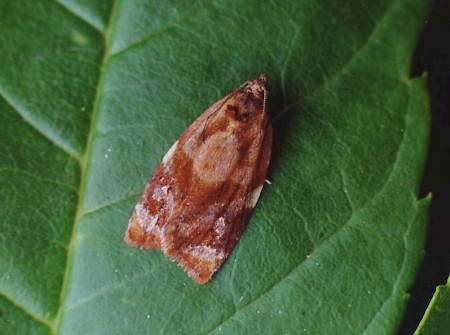49.004 BF1010
Red-barred Tortrix Ditula angustiorana
(Haworth, 1811)
Wingspan 12-18 mm.
With an average wingspan of around 15mm, this is quite a small species, though the females are usually slightly larger, and differ slightly in markings and colour.
It is to be found throughout much of Britain, though less commonly further north, and the adults are on the wing in June and July.
The males sometimes fly in sunshine, and both sexes fly at night, and come to light.
Various trees and shrubs are used as foodplants.
- Larva: (description Ian F. Smith):
Foodplants: August to May. Polyphagous on trees and shrubs, including Sorbus aucuparia, and (BTS) Malus, Pyrus, Prunus, Vitus, Taxus, Juniperus, Pinus sylvestris, Larix, Viscum, Hedera, Rhododendron, Quercus, Ilex, Buxus, Laurus and Hippophae. Feeding habits vary with foodplant species. In spun leaves, flower buds and/or fruits. BTS state that, after winter diapause, larvae continue feeding in early spring, but the illustrated larva emerged as an imago without any food available in spring, apart from the mouldy remnants of Sorbus aucuparia fruits.
Early instar Length: 7 mm, September, described.
Head: Burnt ochre. Dorsally shaded darker; brown ochre. Posterior thinly edged black. Elongate black lateral mark almost reaching black stemmatal area.
Prothoracic shield: Translucent burnt ochre. Posterior darker; van dyke brown.
Thoracic legs: Translucent yellow brown marked with darker brown. Coxa concolorous with body, with a thin dark brown collar on inner face.
Body: Yellowish white, shaded cinnamon dorsally. Anteriorally, sometimes with strong rosy tint.
Spiracles: Small and unobtrusive. Peritreme dark brown.
Pinacula: Yellowish white, concolorous with flanks and venter, so only conspicuous on dorsum.
Setae: Translucent. Slightly tinted yellowish brown basally.
Anal segment: Anal comb with about six brown prongs. Anal plate yellowish brown.
Prolegs: Concolorous with venter. Crochets reddish brown.Late instar The description in BTS, probably of last instar in May, differs in the following:
Thoracic legs: Light green with blackish terminal segments.
Body: Light yellowish green to brownish green, or grey.
Pinacula: Light green, most conspicuous on darker dorsal region.
Anal segment: Anal comb with four yellowish or brown prongs. Anal plate brown or greenish, weakly marked with brown.Similar species: When on fruits of Sorbus aucuparia, feeding signs resemble those of Argyresthia conjugella, but the larvae are distinct.

 UKMoths
UKMoths 









